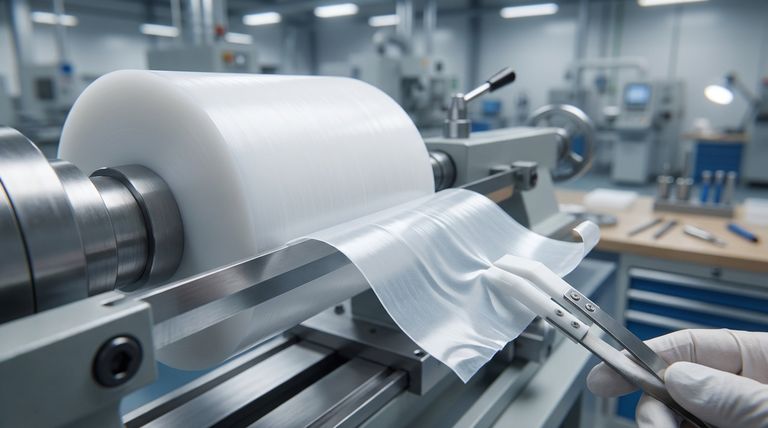The fundamental challenge in manufacturing skived PTFE sheets is maintaining consistent physical properties throughout the entire process. This begins with the initial molded cylinder, or "billet," from which the sheets are cut, where variations in density and internal stress are inevitably introduced. These inconsistencies are then transferred directly into the final product.
The core issue is not the skiving (slicing) process itself, but the inherent difficulty in creating a perfectly uniform PTFE billet. Any variation within this foundational billet will directly translate into performance differences in the final sheets.

The Root of the Challenge: The PTFE Billet
The quality of a skived sheet is determined long before the cutting blade ever touches the material. The initial molding and heating of the raw PTFE resin sets the stage for all subsequent challenges.
The Molding and Sintering Process
Polytetrafluoroethylene (PTFE) is not melt-processed like common plastics. Instead, the powdered resin is compressed into a solid cylindrical shape called a preform or billet. This billet is then heated in a process called sintering, where the particles fuse together without melting.
Inconsistent Internal Density
Achieving perfectly uniform compaction pressure throughout a large billet is extremely difficult. The outer regions often become denser than the core. Similarly, precise temperature control during sintering is critical, as any gradient can lead to variations in how the particles fuse, further affecting density.
Locked-in Internal Stresses
The combination of high pressure and thermal cycling during the molding and sintering process locks internal stresses into the billet. These stresses are not visible but create instability within the material's structure.
How Billet Flaws Affect the Final Sheet
The skiving process, where a thin film is precisely peeled from the rotating billet, acts as a diagnostic tool, revealing the billet's internal inconsistencies.
The Skiving Mechanism
Think of skiving like peeling a potato or shaving wood veneer. A long, sharp blade shaves a continuous sheet from the billet as it spins on a lathe. The sheet's properties are a direct reflection of the properties of the billet at that specific layer.
Variable Mechanical Properties
A sheet skived from the denser outer portion of a billet will exhibit slightly different tensile strength, elongation, and dielectric properties than a sheet taken from the less-dense inner core. For demanding applications in electronics or aerospace, this lack of uniformity can be a critical point of failure.
Poor Dimensional Stability
When a layer is skived off, the internal stresses from that layer are released. This can cause the thin sheet to warp, curl, or fail to lay perfectly flat. This makes handling and secondary processing, like adhesive bonding, much more difficult.
Mitigating Inconsistency in Production
Experienced manufacturers employ rigorous process controls to minimize these inherent challenges and produce a more reliable and uniform product.
Premium Raw Material
The process must begin with high-quality, virgin PTFE resin with a consistent particle size and distribution. Using lower-grade or reprocessed material exacerbates all subsequent problems.
Precision Process Control
Strict control over molding pressures and sintering temperature profiles is paramount. By minimizing pressure and temperature gradients within the billet, manufacturers can reduce the formation of density variations.
Post-Sintering Annealing
To address the critical issue of internal stress, high-quality billets undergo a secondary thermal cycle known as annealing or stress-relieving. This carefully controlled heating and cooling process allows the polymer chains to relax, significantly reducing locked-in stress and improving the final sheet's dimensional stability.
Sourcing and Specifying for Your Goal
Understanding these manufacturing realities allows you to make more informed decisions when specifying or purchasing skived PTFE sheets.
- If your primary focus is critical performance (aerospace, medical, high-frequency electronics): Demand sheets made from premium, stress-relieved billets and ask for documentation on quality control and property testing.
- If your primary focus is general purpose use (gaskets, liners, chemical barriers): Standard-grade skived sheets may be perfectly adequate, but you should anticipate minor variations in thickness and flatness.
By understanding the manufacturing process, you can better align your material specification with the true requirements of your application.
Summary Table:
| Challenge | Root Cause | Impact on Final Sheet |
|---|---|---|
| Inconsistent Properties | Variations in billet density and internal stress from molding/sintering. | Variable tensile strength, elongation, and dielectric properties. |
| Poor Dimensional Stability | Locked-in internal stresses within the PTFE billet. | Warping, curling, and difficulty in handling or bonding. |
| Material Uniformity | Difficulty in achieving perfect compaction and temperature control. | Performance differences between sheets from the same billet. |
Need Skived PTFE Sheets with Guaranteed Consistency?
At KINTEK, we specialize in manufacturing high-precision PTFE components, including custom skived sheets. We understand that your applications in the semiconductor, medical, and laboratory industries demand unwavering material uniformity and performance.
We mitigate manufacturing challenges by:
- Using premium, virgin PTFE resins.
- Employing precision process controls for molding and sintering.
- Implementing post-sintering annealing to relieve internal stresses.
This ensures the skived sheets you receive exhibit superior dimensional stability and consistent mechanical properties, batch after batch.
Let us provide the reliable PTFE solution your project requires. Contact KINTEK today to discuss your custom fabrication needs, from prototypes to high-volume orders.
Visual Guide

Related Products
- Custom PTFE Parts Manufacturer for Teflon Parts and PTFE Tweezers
- Custom PTFE Parts Manufacturer for Teflon Containers and Components
- Custom PTFE Sleeves and Hollow Rods for Advanced Applications
- Custom PTFE Sealing Tapes for Industrial and High Tech Applications
- Custom PTFE Square Trays for Industrial and Laboratory Use
People Also Ask
- What factors should be considered when choosing between Nylon and PTFE? Select the Right Material for Your Application
- What fabrication services are available for PTFE? Shearing, Stamping, Laser Cutting, Molding & Machining
- What challenges arise when machining PTFE (Teflon)? Overcome Softness, Heat, and Instability
- What design considerations are important for custom PTFE parts? Design for Performance & Reliability
- What are the main applications of PTFE type Teflon? Unlock Its Versatility for Your Industry



















